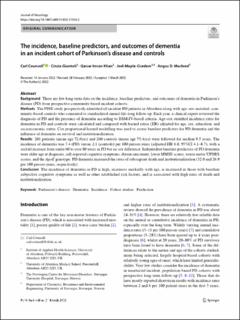| dc.contributor.author | Counsell, Carl | |
| dc.contributor.author | Giuntoli, Cinzia | |
| dc.contributor.author | Khan, Qaisar Imran | |
| dc.contributor.author | Maple-Grødem, Jodi | |
| dc.contributor.author | Macleod, Angus D. | |
| dc.date.accessioned | 2023-03-15T09:37:45Z | |
| dc.date.available | 2023-03-15T09:37:45Z | |
| dc.date.created | 2022-04-27T12:05:51Z | |
| dc.date.issued | 2022 | |
| dc.identifier.citation | Counsell, C., Giuntoli, C., Khan, Q.I. et al. The incidence, baseline predictors, and outcomes of dementia in an incident cohort of Parkinson’s disease and controls. J Neurol 269, 4288–4298 (2022). | en_US |
| dc.identifier.issn | 0340-5354 | |
| dc.identifier.uri | https://hdl.handle.net/11250/3058301 | |
| dc.description.abstract | Background
There are few long-term data on the incidence, baseline predictors, and outcomes of dementia in Parkinson’s disease (PD) from prospective community-based incident cohorts.
Methods
The PINE study prospectively identified all incident PD patients in Aberdeen along with age–sex-matched, community-based controls who consented to standardized annual life-long follow-up. Each year, a clinical expert reviewed the diagnosis of PD and the presence of dementia according to DSM-IV-based criteria. Age–sex stratified incidence rates for dementia in PD and controls were calculated and compared with hazard ratios (HR) adjusted for age, sex, education, and socioeconomic status. Cox proportional-hazard modelling was used to assess baseline predictors for PD dementia and the influence of dementia on survival and institutionalization.
Results
201 patients (mean age 72.6yrs) and 260 controls (mean age 75.4yrs) were followed for median 9.5 years. The incidence of dementia was 7.4 (PD) versus 2.1 (controls) per 100 person-years (adjusted HR 6.0, 95%CI 4.1–8.7), with a sixfold increase from under 60 to over 80 years in PD but no sex difference. Independent baseline predictors of PD dementia were older age at diagnosis, self-reported cognitive symptoms, dream enactment, lower MMSE scores, worse motor UPDRS scores, and the ApoE genotype. PD dementia increased the rates of subsequent death and institutionalization (32.0 and 26.9 per 100 person-years, respectively).
Conclusion
The incidence of dementia in PD is high, increases markedly with age, is increased in those with baseline subjective cognitive symptoms as well as other established risk factors, and is associated with high rates of death and institutionalization. | en_US |
| dc.language.iso | eng | en_US |
| dc.publisher | Springer | en_US |
| dc.rights | Navngivelse 4.0 Internasjonal | * |
| dc.rights.uri | http://creativecommons.org/licenses/by/4.0/deed.no | * |
| dc.title | The incidence, baseline predictors, and outcomes of dementia in an incident cohort of Parkinson’s disease and controls | en_US |
| dc.type | Peer reviewed | en_US |
| dc.type | Journal article | en_US |
| dc.description.version | publishedVersion | en_US |
| dc.rights.holder | the authors | en_US |
| dc.subject.nsi | VDP::Medisinske Fag: 700 | en_US |
| dc.source.pagenumber | 4288–4298 | en_US |
| dc.source.volume | 269 | en_US |
| dc.source.journal | Journal of Neurology | en_US |
| dc.identifier.doi | 10.1007/s00415-022-11058-2 | |
| dc.identifier.cristin | 2019434 | |
| cristin.ispublished | true | |
| cristin.fulltext | original | |
| cristin.qualitycode | 2 | |

